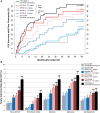APOE genotype, hypertension severity and outcomes after intracerebral haemorrhage
- PMID: 32954261
- PMCID: PMC7425529
- DOI: 10.1093/braincomms/fcz018
APOE genotype, hypertension severity and outcomes after intracerebral haemorrhage
Abstract
Intracerebral haemorrhage in the elderly is a severe manifestation of common forms of cerebral small vessel disease. Nearly 60% of intracerebral haemorrhage survivors will develop clinical manifestations of small vessel disease progression including recurrent haemorrhage, ischaemic stroke, dementia, late-life depression and gait impairment within 5 years. Blood pressure measurements following intracerebral haemorrhage are strongly associated with this risk. However, aggressive blood pressure lowering in the elderly carries substantial risks. In order to determine whether there might be an opportunity to select individuals at the highest risk for small vessel disease progression for aggressive blood pressure reduction, we investigated whether APOE gene variants ɛ2/ɛ4 modify the association between blood pressure and small vessel disease clinical progression after intracerebral haemorrhage. We conducted a single-centre longitudinal study at a tertiary care referral centre (Massachusetts General Hospital in Boston, MA, USA), analysing 716 consecutive survivors of acute intracerebral haemorrhage, enrolled from January 2006 to December 2016. We conducted research interviews at the time of enrolment and obtained APOE genotypes from peripheral venous blood samples. We followed patients longitudinally by means of validated phone-based research encounters, aimed at gathering measurements of systolic and diastolic blood pressure, as well as information on small vessel disease clinical outcomes (including recurrent haemorrhage, incident ischaemic stroke, incident dementia, incident depression and incident gait impairment). APOE ε4 and systolic blood pressure were associated with the risk of recurrent haemorrhage, ischaemic stroke and post-haemorrhage dementia, depression and gait impairment (all P < 0.05). APOE ε4 and systolic blood pressure interacted to increase the risk of recurrent haemorrhage, ischaemic stroke, dementia and gait impairment (all interaction P < 0.05). Among patients with elevated blood pressure following intracerebral haemorrhage (average systolic blood pressure 120-129 mmHg and diastolic blood pressure <80 mmHg) only those with one or more APOE ε4 copies were at increased risk for one or more small vessel disease outcomes (hazard ratio = 1.97, 95% confidence interval 1.17-3.31). Among haemorrhage survivors with hypertension (stage 1 and beyond) APOE genotype also stratified risk for all small vessel disease outcomes. In conclusion, APOE genotype modifies the already strong association of hypertension with multiple small vessel disease clinical outcomes among intracerebral haemorrhage survivors. These data raise the possibility that genetic screening could inform blood pressure treatment goals in this patient population.
Keywords: APOE; hypertension; intracerebral haemorrhage.
© The Author(s) (2019). Published by Oxford University Press on behalf of the Guarantors of Brain.
Figures



References
-
- Adams HP Jr, Bendixen BH, Kappelle LJ, Biller J, Love BB, Gordon DL, et al. Classification of subtype of acute ischemic stroke. Definitions for use in a multicenter clinical trial. TOAST. Trial of Org 10172 in acute stroke treatment. Stroke 1993; 24: 35–41. - PubMed
-
- Almeida OP, Almeida SA.. Short versions of the Geriatric Depression Scale: a study of their validity for the diagnosis of a major depressive episode according to ICD-10 and DSM-IV. Int J Geriatr Psychiatry 1999; 14: 858–65. - PubMed
-
- Barber M, Stott DJ.. Validity of the Telephone Interview for Cognitive Status (TICS) in post-stroke subjects. Int J Geriatr Psychiatry 2004; 19: 75–9. - PubMed
-
- Benedictus MR, Hochart A, Rossi C, Boulouis G, Henon H, van der Flier WM, et al. Prognostic factors for cognitive decline after intracerebral hemorrhage. Stroke 2015; 46: 2773. - PubMed
Grants and funding
LinkOut - more resources
Full Text Sources
Miscellaneous
